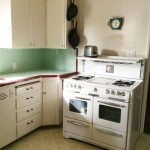What Is The Average Kitchen Size?
Determining the average kitchen size is not a straightforward process, as kitchen dimensions vary considerably based on several factors, including housing type, geographical location, architectural style, and the intended purpose of the space. Understanding these influencing elements is crucial to grasp the nuances of kitchen sizing and to discern what might be considered typical within specific contexts.
The kitchen, historically a purely utilitarian space, has evolved into a central hub for modern homes. It serves not only as a cooking and food preparation area but also as a gathering place for families and friends, a workspace, and even an entertainment zone. This shift in function necessitates a more comprehensive consideration of size and layout to accommodate the diverse needs of contemporary households. Consequently, the average kitchen size is best understood as a range rather than a single, definitive number.
Historically, kitchens were often smaller, enclosed spaces, designed primarily for the practical tasks of cooking and cleaning. As architectural styles evolved and open-concept living became more popular, kitchens began to expand and integrate with other living areas. This change in design philosophy has significantly impacted the overall size and configuration of modern kitchens. Architects and designers now prioritize creating kitchens that are both functional and aesthetically pleasing, often incorporating islands, breakfast bars, and ample storage solutions, which naturally contribute to a larger footprint.
Furthermore, the availability of space within a dwelling directly influences the size of the kitchen. A sprawling suburban home will likely feature a larger kitchen than a compact urban apartment. Economic factors also play a role, as larger kitchens generally require more expensive materials and appliances. Therefore, understanding the interplay of these different factors is essential when evaluating the average kitchen size.
Factors Influencing Kitchen Size
Several factors influence the size of a kitchen, each contributing uniquely to the overall dimensions of the space. Recognizing these factors is essential for interpreting kitchen size data accurately and applying it appropriately to specific design or renovation projects.
One prominent factor is the type of residence. Condominiums typically feature smaller kitchens compared to single-family homes. Townhouses usually offer kitchens of intermediate size, reflecting their position in terms of space and design between apartments and detached houses. In addition to building type, the overall square footage of the house significantly dictates the size of the kitchen. Generally, the larger the house, the more substantial the kitchen will be.
Geographical location also impacts kitchen size. In urban areas, where space is at a premium, kitchens tend to be smaller and more efficiently designed. Conversely, in suburban or rural areas, where land is more readily available, kitchens may be more expansive. Regional preferences for cooking styles, entertaining habits, and family size also contribute to variations in kitchen size across different geographic regions. For instance, homes in regions known for their culinary traditions may prioritize larger kitchens to accommodate extensive cooking activities.
Architectural style significantly shapes the dimensions and layout of kitchens. Modern homes often feature open-concept kitchens that flow seamlessly into living and dining areas. These kitchens tend to be larger and more integrated into the overall design of the house. Older homes, especially those built before the mid-20th century, may have smaller, more compartmentalized kitchens. Historic homes often require careful consideration to preserve their original character while updating the kitchen for modern use.
Analyzing Average Kitchen Sizes by Housing Type
To gain a more granular understanding of average kitchen size, it is helpful to analyze data based on specific housing types. This approach allows for a more accurate comparison and application of size benchmarks to particular design scenarios.
In apartments and condominiums, the average kitchen size typically ranges from 70 to 100 square feet. These kitchens are often designed to maximize efficiency in a limited space, utilizing compact appliances and smart storage solutions. Galley kitchens, characterized by two parallel runs of cabinets and appliances, are common in apartments due to their space-saving design. Open-concept kitchens, where the kitchen is integrated with the living area, are also prevalent in modern apartments, helping to create a sense of spaciousness.
For townhouses, the average kitchen size generally falls between 100 and 150 square feet. Townhouse kitchens are often larger than those in apartments, reflecting the greater overall square footage of the residence. They may include features such as a small island or breakfast bar, providing additional workspace and seating. L-shaped kitchens, which wrap around two walls, are a popular design choice in townhouses, offering a balance of functionality and space efficiency.
Single-family homes typically boast the largest kitchens, with average sizes ranging from 150 to 300 square feet or more. These kitchens often incorporate features such as large islands, multiple work zones, and ample storage space. U-shaped kitchens, which wrap around three walls, are common in larger single-family homes, providing abundant counter space and storage. Open-concept designs are also prevalent, with kitchens seamlessly integrated into living and dining areas, fostering a sense of connection and flow.
Luxury homes often feature kitchens exceeding 300 square feet, equipped with top-of-the-line appliances, custom cabinetry, and specialized features such as wine refrigerators and warming drawers. These kitchens are designed to accommodate professional-grade cooking and entertaining, reflecting a high level of attention to detail and functionality.
Measuring and Calculating Kitchen Size
Accurately measuring and calculating kitchen size is essential for design, renovation, and real estate purposes. The process involves precise measurements and a clear understanding of how to calculate square footage. This information provides a foundational understanding of the available space.
The most common method for measuring kitchen size is to use a measuring tape to determine the length and width of the room. Measurements should be taken at multiple points to account for any irregularities in the walls. For irregular shapes, divide the kitchen into smaller, more regular shapes (such as rectangles and squares) and measure each section separately. Then, calculate the area of each section and add them together to determine the total square footage.
To calculate the square footage of a rectangular kitchen, multiply the length by the width (Area = Length x Width). For example, if a kitchen is 12 feet long and 10 feet wide, the square footage would be 120 square feet (12 ft x 10 ft = 120 sq ft). For more complex shapes, it may be necessary to use more advanced geometric formulas or online calculators.
When evaluating kitchen size, it is important to consider not only the total square footage but also the usable space. Obstacles such as appliances, cabinets, and islands can impact the flow and functionality of the kitchen. Designers often use layout planning software to visualize the space and optimize the arrangement of elements. These tools allow for accurate measurements and simulations, ensuring that the kitchen design is both aesthetically pleasing and highly functional.
Understanding average kitchen sizes provides a valuable reference point for evaluating existing kitchens or planning new designs. By considering the various factors that influence kitchen size, and by accurately measuring and calculating square footage, individuals can make informed decisions about kitchen design and functionality.
Ultimately, determining the ideal kitchen size is a highly personalized process, influenced by individual needs, lifestyle, and aesthetic preferences. The information provided here offers a comprehensive framework for understanding average kitchen sizes, but the ultimate decision should be based on a careful evaluation of specific requirements and priorities.

What Is The Average Kitchen Size For All Types Of Homes Foyr

What Is The Average Kitchen Size For All Types Of Homes Foyr

What Is The Average Kitchen Size For All Types Of Homes Foyr

Average Kitchen Size Greensboro Kernersville Winston M Dixon Custom Cabinetry

7 Types Of Kitchen Floor Plans With Dimensions Foyr Neo

7 Types Of Kitchen Floor Plans With Dimensions Foyr Neo

What Is The Average Size Of Kitchens In Usa You Might Be Surprised

Kitchen And Dining Area Measurements Standards Guide

The Size Of An Average Kitchen In Trend Monitor

Heat Takes On A New Meaning In An Average Size Kitchen








